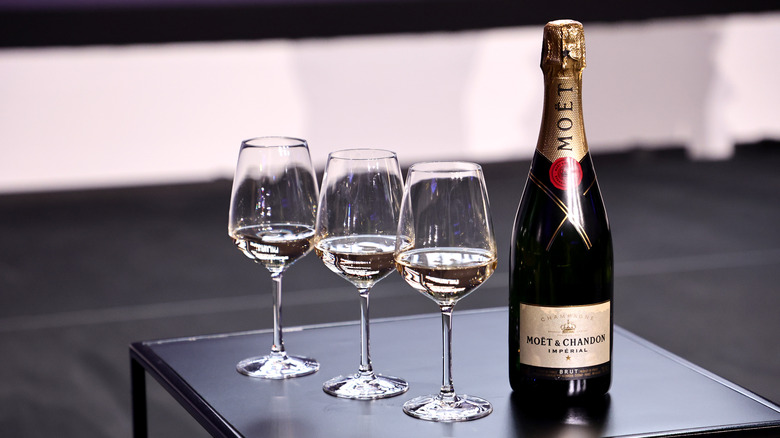What's The Difference Between Cava And Champagne?
Celebrating a big promotion, engagement party, or New Year's Eve wouldn't be quite the same without the sound of a cork popping loudly while partygoers race to catch a spray of bubbly shooting from a green glass bottle. But many people don't pay attention to what's actually in their bottle of bubbly as long as it's, well, bubbly. There is a diverse array of sparkling wines from around the world, from South African Cap Classique to Alsatian crémant, with the most famous being French Champagne.
But not everyone can shell out for an expensive bottle of Dom Pérignon, which explains the growing popularity of other European sparkling wines, like Italian prosecco or Spanish cava. Cava, in particular, has steadily gained in popularity, distinguished by its similarities to and a few notable differences from Champagne. But what is cava, and what exactly makes it different from Champagne?
What is Champagne?
Most people probably know that Champagne must be produced in the Champagne region of France. It is true that Champagne is exclusively made in the French northeast, where crisp climates result in dry wines with a unique terroir. But what defines Champagne is not merely location and sparkling wine produced in Champagne does not automatically qualify for the title.
Champagne is produced using a technique known as the méthode champenoise or méthode traditionnelle (which refers to the process outside of this region). After initial fermentation, Champagne is blended and bottled with additional sugar and yeast and goes through a second fermentation in the bottle. Champagne must then age for a minimum of 15 months in a winemaker's cellar before it can be sold (though many age for longer), with vintages aging for at least three years.
Champagne is made with Pinot Noir, Pinot Meunier, or Chardonnay grapes and is typically a combination of the three. These varietals, combined with Champagne's long aging period, result in a sparkling wine that is light and fruity similar to a pear or apple and usually has distinct brioche notes.
What is cava?
Just as Champagne is native to France, cava is a specialty of Spain, with 95% of all cava manufactured in northeastern Spain (per Glass and Vine). Like Champagne, cava is a sparkling wine made with white wine grapes, though cava is generally made with Macabeo, Parellada, and Xarel-lo varietals. Cava also uses the méthode traditionnelle, which involves a second fermentation in the bottle.
However, cava differs from Champagne in a few ways. While Champagne is aged for a minimum of 15 months, cava usually spends a scant 9 months in the cellar. This means that cava doesn't achieve the same toasty breadlike flavors that additional aging time gives to Champagne. Instead, cava is slightly sweeter than Champagne and remains sprightly and acidic when poured. Although similar to Champagne with fresh citrus and pear notes, cava also has a certain savory minerality to it.
Another significant difference between cava and Champagne is price. Vineyard acreage in Champagne is prohibitively expensive, and certain aspects of winemaking, like tirage, are done by hand, which drives up prices (as does the power of a brand name). Cava, on the other hand, is much more budget-friendly and makes a great substitute for Champagne.


